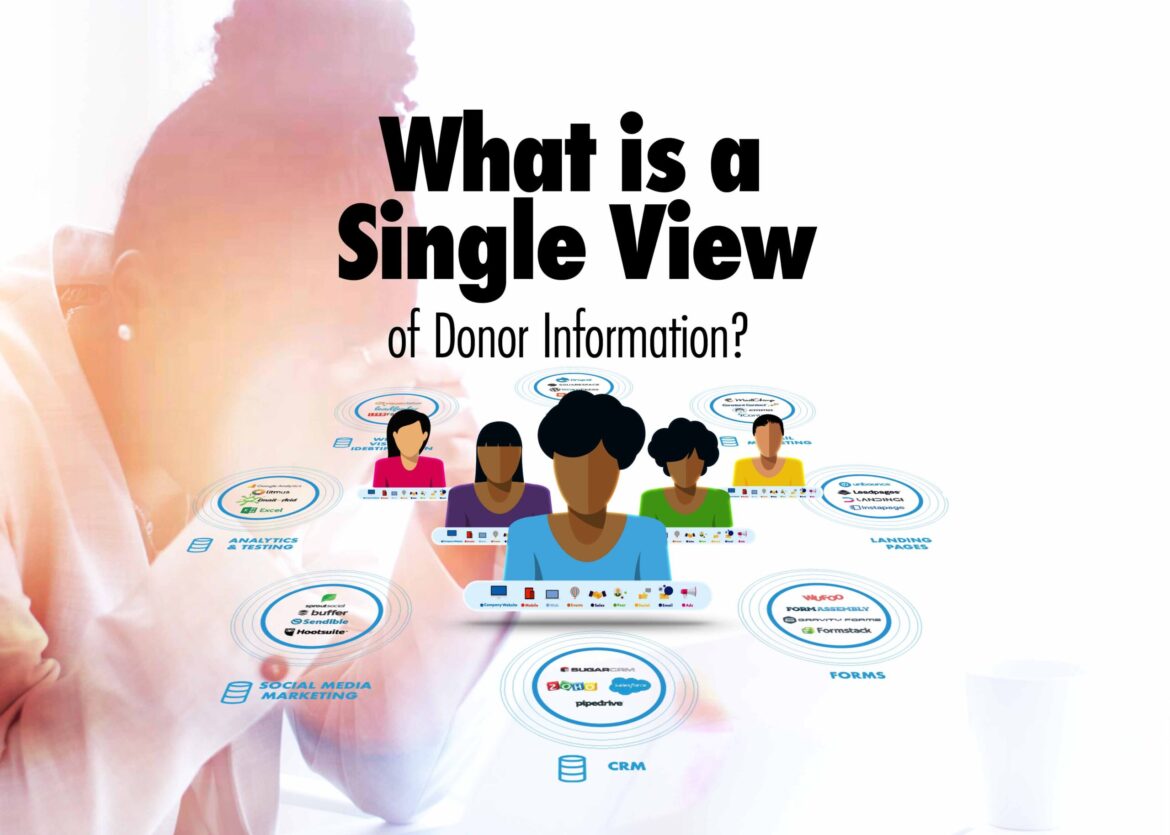Using a single donor view across your organization ensures that the information about your customer from each part of their journey is accurate, up-to-date, and will help inform the relevant communications you’ll send in the future.
In which I try to explain a seemingly complicated marketing term in the clearest language possible.
I ran a simple Google search to see what was out there, and of course the Wikipedia entry is the first result. I’m going to copy exactly what the Wikipedia page for ‘single customer view’ says…
A single donor view of information is an aggregated, consistent and holistic representation of the data known by an organization about its customers. Yep. Well, that’s a bit of a confusing mess of fancy words, especially since it includes the word ‘holistic’.
What is a single donor view of information?
Having a single donor view of information means having a connected view of each individual donor, consolidating all relevant data and information into one centralized database. This includes not only basic contact information such as name, address, and phone number, but also more detailed information such as donation history, communication preferences, engagement levels, and any other relevant interactions with the organization.
By having a comprehensive and unified representation of donors, organizations can gain valuable insights into their donor base. This allows them to better understand donor behavior, preferences, and motivations, which in turn enables them to tailor their communication and fundraising strategies accordingly. For example, if an organization knows that a particular donor prefers to receive communication via email rather than direct mail, they can adjust their outreach efforts to maximize engagement and response rates.
Why a single donor view of information matter for nonprofits?
Besides, a single view of information facilitates effective decision-making. With accurate and up-to-date data from every stage of the donor’s journey, organizations can analyze trends, identify patterns, and make informed decisions about fundraising campaigns, donor segmentation, and resource allocation. For instance, if an organization notices that a certain group of donors consistently gives larger donations during a specific time of the year, they can strategically plan their fundraising efforts to capitalize on this trend.
In addition, a single view of information helps organizations avoid duplication and inconsistencies in their donor data. By centralizing all donor information, organizations can ensure that data is accurate, complete, and up-to-date. This eliminates the risk of sending duplicate communications or outdated information to donors, which can be frustrating and potentially damage the organization’s relationship with the donor.
Overall, having a single view of information is essential for effective communication and decision-making in the nonprofit sector. It allows organizations to have a comprehensive understanding of their donors, enabling them to build stronger relationships, increase donor loyalty, and ultimately achieve their fundraising goals.
What is multi-channel fundraising?
Multichannel donor communication is a strategy that enables donors to interact with a brand or organization through various communication channels. These channels can include email, social media, live chat, telephone, and online forms. The purpose of implementing a multichannel fundraising approach is to ensure that donors have a seamless and consistent experience, regardless of the channel they choose to engage with.
However, achieving this level of consistency can be challenging for fundraising teams. Donors often switch between channels for even the simplest tasks, which can make it difficult for fundraising representatives to keep track of the donor’s history and provide personalized assistance. For example, a donor may start a conversation via email but then switch to live chat to get a quicker response. This constant channel switching can lead to disjointed conversations and a lack of continuity in the donor’s experience.
Another challenge arises when different teams within the same organization manage these communication channels with different goals and priorities. For instance, the social media team may focus on building brand awareness and engagement on social media, while the email team may prioritize delivering personalized messages and updates. This discrepancy in goals and priorities can result in a varied experience for donors across different channels, leading to confusion and frustration.
To overcome these challenges, organizations need to implement strategies that promote a unified and consistent donor experience across all channels. This can involve integrating marketing and fundraising platforms that allow representatives to access donor information and conversation history across channels. By having a practical view of the donor’s interactions, fundraising teams can provide more personalized and efficient assistance.
Additionally, organizations should establish clear guidelines and protocols for fundraising teams to follow, regardless of the channel they are managing. This ensures that all teams are aligned in their approach and that donors receive consistent and high-quality support, regardless of the channel they choose to communicate through.
Furthermore, organizations can leverage technology and automation to streamline the multichannel donor communication process. For example, implementing chatbots or automated email responses can help handle simple inquiries and provide immediate assistance, freeing up marketing and fundraising staff to focus on more complex issues.
In conclusion, while multichannel donor communication offers numerous benefits, it also presents challenges for fundraising teams. By implementing strategies that promote consistency, integrating fundraising platforms, establishing clear guidelines, and leveraging technology, organizations can provide a seamless and unified donor experience across all channels. This ultimately leads to increased donor satisfaction and loyalty.







